Golden Gate Park (East)
- » East Section East Edge Horseshoe Courts McLaren Lodge Alvord Lake Alvord Bridge Fuchsia Dell Peacock Meadow Sharon Meadow Sharon Building Children's Playground Kezar Stadium John F Kennedy Drive Martin Luther King Jr Drive Arizona Garden Dahlia Garden Conservatory of Flowers Clarke Gate Raccoon Hollow/Live Oak Ghiradelli Rustic Shelter George Washington Elm Tree Fern Dell Lily Pond AIDS Memorial Grove Tennis Courts Lawn Bowling Courts Brayton Gate Skate Area Garden of Humanitarians Powell Railroad Entrance Brown Gate McLaren Rhododendron Dell Maintenance Yard/Nursery Whiskey Hill
- Middle Section Fulton Playground JFK Pedestrian Tunnel Music Concourse DeYoung Museum Academy of Sciences Shakespeare Garden Big Rec Ball Field Heroes Grove Japanese Tea Garden Botanical Garden Rose Garden Redwood Memorial Grove Colonial Historic Trees Pioneer Log Cabin Rainbow Falls Prayerbook Cross Stow Lake Roman Bridge Rustic Bridge Strawberry Hill Huntington Falls Chinese Pavilion Mothers Meadow Breon Gate Crossover Drive Transverse Drive Middle Drive West Lloyd Lake Portals of the Past Elk Glen Lake Washington Bicentennial Grove
- West Section Marx Meadow Disc Golf Course Speedway Meadow Urban Forestry Center Mallard Lake Metson Lake Lindley Meadow Spreckels Lake Rhododendron Island Golden Gate Park Stables Police Stables Polo Field Par Course South Bridle Path Senior Citizen's Center Pentaque Court Dog Training Area Bison Paddock Fly Casting Pools Chain of Lakes: North Lake Chain of Lakes: Middle Lake Chain of Lakes: South Lake Bercut Equitation Ring Archery Field Golf Course Murphy Windmill Soccer Fields Park Chalet Dutch Windmill Queen Wilhelmina Tulip Garden West Edge
For a summary of park features with point-by-point locations, see the Golden Gate Park guide map. See also Historic Images and Postcards.
Now: Three miles long and half a mile wide, Golden Gate Park is a sprawling patchwork of lawns, gardens, meadows, lakes, and paths that go in every direction but straight. It would be virtually impossible to see all of the park in a single day - and why would you try, because this place was designed for leisure.
Then: Ingeniously cultivated from barren dunes during the late 1800s, Golden Gate Park was already referred to as "famous" and "old" by the turn of the 20th century, and several of its major features date back to that time. The Conservatory of Flowers first opened in 1879, and the Music Stand area and Japanese Tea Garden were originally built for the California Midwinter International Exposition of 1894. See related postcards.
How To Get There: The east section of Golden Gate Park has many possible entry points. Visitors to the Upper Haight often cross Stanyan Street and find the paths that lead in. A nice starting point for the east section is close to where Hayes Street ends at Stanyan, and walking paths lead toward the Conservatory of Flowers. Fulton Street is popular for parking, since it is unmetered, and directly borders the park on the north. From the south side, a good route is 9th Street in the Inner Sunset (though car traffic can be heavy near the entrance). Better to take the Muni N-Judah if possible, to 9th and walk into the park.
For much more information on Golden Gate Park, see Christopher Pollock's impeccably researched and beautifully written book, San Francisco's Golden Gate Park.
East Edge
- Back to Top
From the end of the Panhandle, the eastern edge of Golden Gate Park stretches a half mile up and down Stanyan Street. McLaren Lodge, Alvord Lake, and Kezar Pavillion are the features most often seen by visitors entering the park on this side. The far northeast corner, with its twisting paths rising up to a small hilltop, and brushy terrain, is often missed.
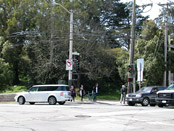
The corner of Stanyan and Fulton Streets, at the northeast corner of Golden Gate Park
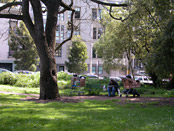
Bench at the northeast corner of the park, at Stanyan and Fulton Streets
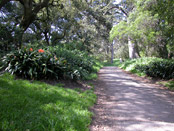
Path leading into the park from the northeast corner
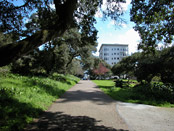
Path leading out to Stanyan Street at the east edge of the park
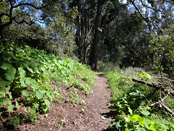
Path in the northeast corner of the park
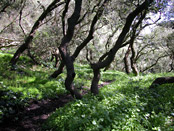
Walking paths through the wooded northeast section of the park
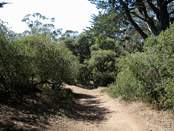
Dog Run - paths through trees and brush at the far northeast corner of the park near Stanyan and Fulton Streets
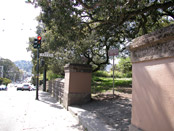
Entrance to the park where Hayes Street ends at Stanyan Street
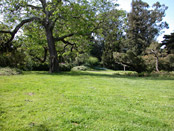
Lawn inside the park entrance at Hayes Street, behind McLaren Lodge
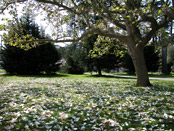
Magnolia leaves on the lawn at the east edge of the park at Stanyan Street near Oak Street
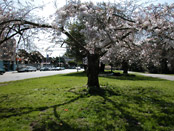
Blossoms on the trees along the east edge of the park at Stanyan Street near Page Street
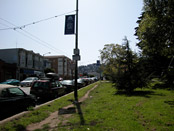
The east edge of Golden Gate Park at Stanyan Street
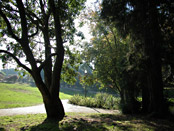
The eastern edge of Golden Gate Park, near the intersection of Stanyan and Haight Streets
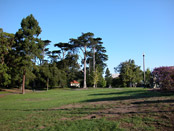
Lawn adjacent to Alvord Lake, at Haight Street
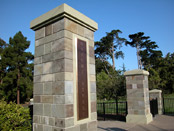
The Haight Street gate entrance to Golden Gate Park
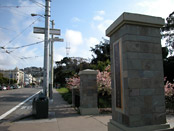
Haight Street, at the entrance to Golden Gate Park
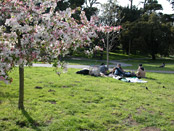
Folks camped out on the lawns are frequently found along the east edge of the park near Haight Street
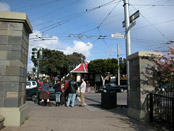
Facing the McDonalds at the corner of Stanyan and Haight Street
Horseshoe Courts
- Back to Top
Formerly part of a rock quarry, the courts were established in this canyon in 1922. The sculptures carved in the rock wall depict a horse (badly falling apart) and a shoe thrower. Rarely used, it's only once in a while that you hear the clang of horseshoes hitting the poles at this semi-hidden pit high in the park's northeast corner.
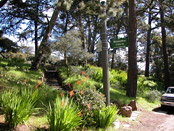
Entrance to the Horseshoe Courts, from Conservatory Drive
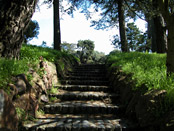
Stairs leading to the Horseshoe Courts from Conservatory Drive
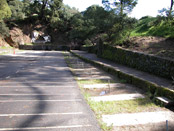
Horseshoe Courts (aka Horseshoe Pits) near Stanyan Street at the end of Grove Street
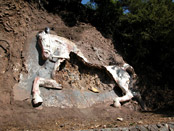
Horse carving on the east wall of the Horseshoe Courts
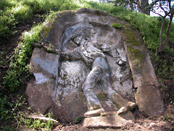
Horseshoe thrower carved on the south wall of the Horseshoe Courts
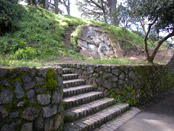
Wall of the Horseshoe Courts
McLaren Lodge
- Back to Top
Built in 1896, this sandstone building served as the Lodge of John McLaren, manager and caretaker of the park from 1887 to 1943. Now it serves as the headquarters for the city's Recreation and Park Department. The Monterey cypress tree in front of the lodge is known as Uncle John's Tree. Its age is unknown. Open 8am to 5pm, weekdays. 415-831-2700.
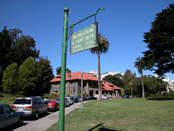
Recreation and Park Department General Office at McLaren Lodge
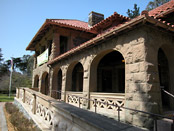
The front of McLaren Lodge and the park headquarters
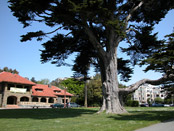
The Monterey cypress known as Uncle John's Tree, in front of McLaren Lodge
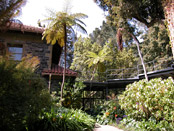
Walkway connecting McLaren Lodge with the offices at 501 Stanyan
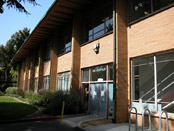
Park offices at 501 Stanyan, behind McLaren Lodge
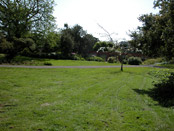
Grassy area just behind McLaren Lodge and the 501 Stanyan Offices
Alvord Lake
- Back to Top
Past the columns at the end of Haight Street, which formally mark the entrance to Golden Gate Park, this small lake is shaded by a cluster of trees. Dating back to the 1880s and the initial development of the east section of the park, the lake lies right on the path that leads under Alvord Bridge and Kezar Drive toward Sharon Meadow. The lake and bridge are named after William Alvord, park commission president and donor of the funds to develop the lake. Early images show a very functional fountain and swans.
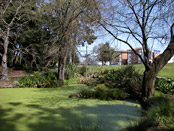
Alvord Lake, with apartment buildings on Stanyan Street in the background
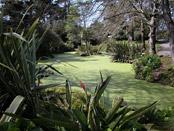
The surface of Alvord Lake is currently green
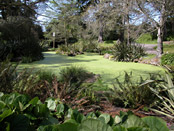
Ferns and reeds around the edge of Alvord Lake
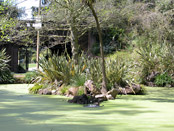
Very small fountain in the middle of Alvord Lake
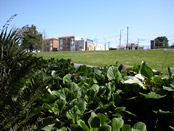
Stanyan Street, over the grassy slope from Alvord Lake
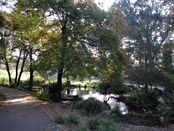
Alvord Lake in the fall
Alvord Bridge
- Back to Top
Dating back to 1889, this is apprently the first bridge built with iron-reinforced concrete. It allows cars to pass over on Kezar Drive, while pedestrians can walk from the east edge of the park into Sharon Meadow without having to cross a street. The ceiling of the cavernous tunnel under the bridge is covered with artificial stalactities, mostly crumbled and broken off.
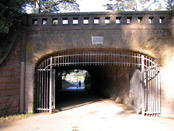
The Alvord Bridge, connecting Kezar Drive over the walkway between Alvord Lake and Sharon Meadow
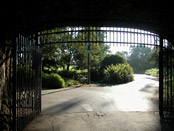
View toward Alvord Lake from inside the pedestrian tunnel
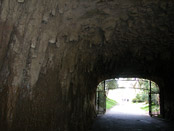
Crumbling stalactites inside the tunnel of Alvord Bridge
Fuchsia Dell
- Back to Top
Dedicated in 1940, the gorgeous network of paths and plantings surrounding this dell lies to the east of the Conservatory of Flowers. The sundial in the center of the dell was installed in 1983. The bushy, light-colored flowers are at their height during the summer.
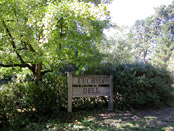
Entrance to the Fuchsia Dell, at Conservatory Drive East
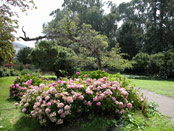
Walking path near the Fuchsia Dell
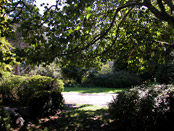
Trees in the Fuchsia Dell area
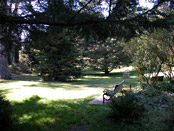
Benches in the clearing near the Fuchsia Dell
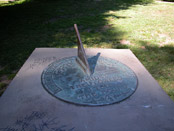
Sundial in the clearing at the Fuchsia Dell
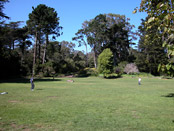
Peacock Meadow, off JFK Drive, east of the Conservatory of Flowers
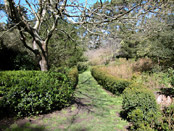
Fuchsia Dell area in March, before the flowers are in season
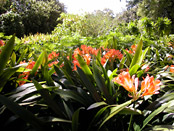
Flowers on the path between the Fuchsia Dell and Conservatory of Flowers
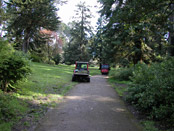
Park maintenance vehicles near the Fuchsia Dell
Peacock Meadow
- Back to Top
Originally named around 1893 for the peacocks set to wander the meadow inside an iron fence, this patch of grass borders JFK Drive just east of the Conservatory of Flowers. This was one of several areas where animals were kept for the viewing pleasure of early park visitors. Other sites included a Bear Pit (where the west end of the AIDS Memorial Grove is now) and an Aviary (on the hill south of the Rhododendron Dell).
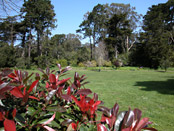
Peacock Meadow from the south side
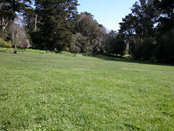
Looking across the grass at Peacock Meadow toward the east
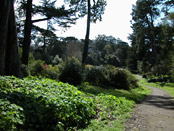
Path leading down to Peacock Meadow from the Fuchsia Dell
Sharon Meadow
- Back to Top
This patchwork of meadows dominates the opening expanse of the park's east side, between the tennis courts to the north and the playground to the south. This meadow, and the sloping hill on its north side (known as Hippie Hill) was a notorious gathering point in the 1960s. Hand drummers are often found at the hill now.
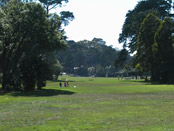
Sharon Meadow, near JFK Drive and the east edge of the park at Stanyan Street
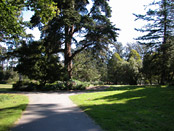
Walking paths connecting the sections of Sharon Meadow
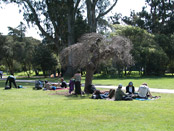
Path along the grassy patches of Sharon Meadow
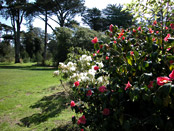
Flowers near the east section of Sharon Meadow, near Kezar Drive
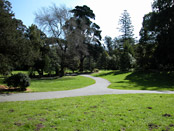
Path at the northeast section of Sharon Meadow near JFK Drive
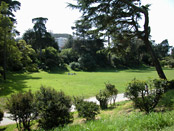
The grassy area known as Little Rec, just east of the Children's Playground
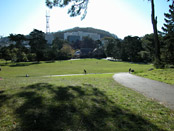
Looking down over Sharon Meadow and the Children's Playground from the hill known as Hippie Hill
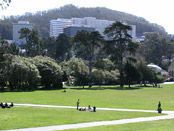
Sharon Meadow, from Hippie Hill, above
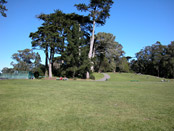
Sharon Meadow and the path over Hippie Hill around the Tennis Courts
Sharon Building
- Back to Top
The Sharon Building opened in 1888, and was meant to be an indoor play area and extension of the playground. It was damaged extensively in the 1906 earthquake (see history), and two subsequent fires (1974 and 1980). It now hosts an art studio with classes for adults and children.
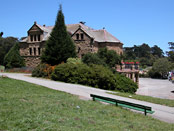
Sharon Building, at the Children's Playground
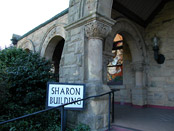
Front entrance of the Sharon Building
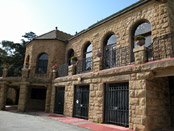
Back of the Sharon Building, facing Sharon Meadow
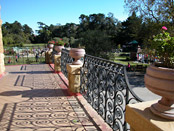
Railing at the top of the Sharon Building
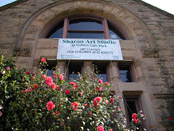
Banner for Sharon Art Studio at the Sharon Building
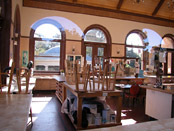
Inside the Sharon Building at the Children's Playground
Children's Playground
- Back to Top
This playground has undergone several changes of face since it opened in 1888. The boat-like swing sets seen in early photos are gone, and a major renovation completed in 2007 brought cement slides, climbing areas, and a re-naming of the area to Koret Children's Quarter. The carousel operating here was built in 1912 and installed at the playground in 1941. Murals in the center of the carousel depict scenes from the park.
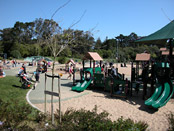
The Children's Playground
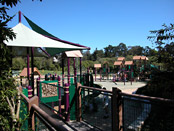
Inside the Children's Playground area
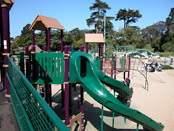
New playground equipment in the Children's Playground
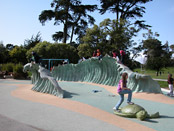
Sculpted wave in the Children's Playground
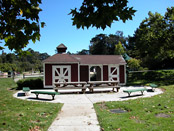
Farmer Brown's Barn, where farm animals used to be kept inside the playground
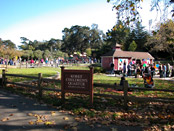
West entrance to the Koret Children's Quarter, or Children's Playground
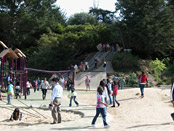
Children playing in the playground
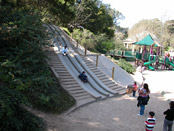
Bottom of the concrete slide in the Children's Playground
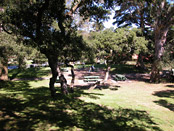
Picnic area just west of the Children's Playground
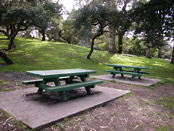
Picnic tables west of the Children's Playground
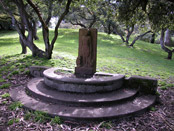
Memorial to Sarah B. Cooper, a pioneer of children's education, just west of the playground
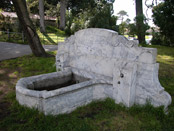
Foresters Memorial Fountain, installed in 1927
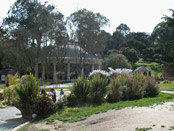
View from the playground, facing south, toward the Carousel
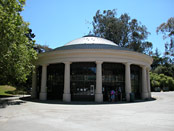
Carousel in the Children's Playground
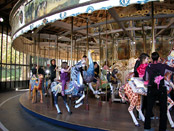
Inside the Carousel in the Children's Playground
Kezar Stadium
- Back to Top
The original, much larger stadium at this location was designed in Roman style by architect Willis Polk and opened in 1925. Eventually proving an unwieldy traffic and parking burden for the neighborhood, it was torn down in 1989 and replaced with the current stadium, known as "Little Kezar". Available to rent for athletic events. 415-831-6305.
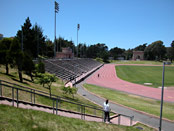
Kezar Stadium, at the southeast edge of Golden Gate Park
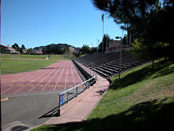
Kezar Stadium bleachers, from the west side
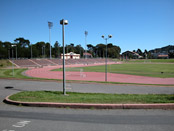
Inside Kezar Stadium, looking east
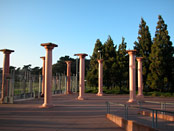
Columns at the entrance to Kezar Stadium
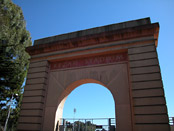
West entrance to Kezar Stadium
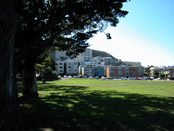
Lawn just west of Kezar Stadium
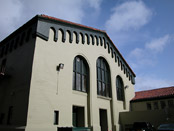
Back of the Kezar Pavilion building, on the east side of Kezar Stadium
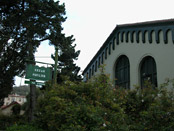
Front of the Kezar Pavilion building on Stanyan Street between Waller and Beulah
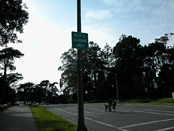
Kezar Drive at Stanyan Street is a bicycle learning area closed to traffic
John F Kennedy Drive
- Back to Top
Renamed in 1967, this was formerly called Main Drive. The Sunday traffic closures also began in 1967, allowing walkers, skaters and bikers to take over the road between Kezar Drive and Transverse Drive. This is the only road that extends (without a name change) all the way from the east end of the park to the west.
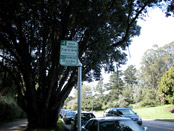
Free parking is available during the day throughout the park, including this busy stretch of JFK Drive
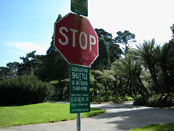
Sign explaining the Park Shuttle, which runs along JFK Drive
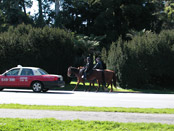
Police on horseback on JFK Drive
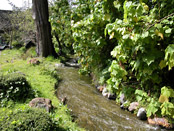
JFK Drive stream and trees
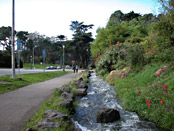
Stream running along edge of JFK drive, near Rainbow Falls
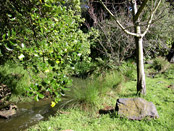
Trees at the edge of the stream along JFK Drive
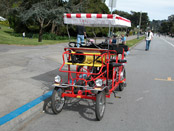
Rented Surrey from the Stow Lake Boathouse on JFK Drive
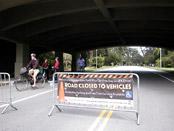
JFK Drive closed from Crossover Drive to the east side of the park on Sunday
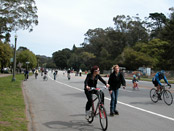
Bicyclists on JFK Drive during the Sunday closure to vehicle traffic
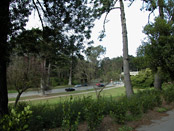
JFK Drive, from Overlook Drive, near Crossover Drive
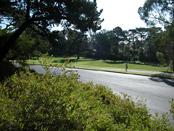
JFK Drive near Lindley Meadow
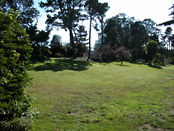
Clearing between Overlook Drive and JFK Drive at Transverse Drive
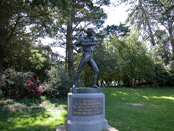
Baseball player statue commemorating the game - not any specific player - given to the park in 1891
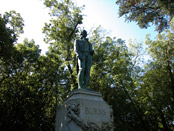
Monument to poet Robert Burns, dedicated in 1908
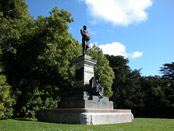
Monument to James Garfield, presented in 1885, is the park's oldest statue
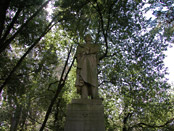
Monument to army commander Henry Halleck, dates to 1886
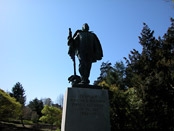
William McKinnon statue, dating to 1927
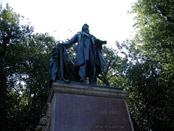
Thomas Starr King statue, presented in 1892
Martin Luther King Jr Drive
- Back to Top
Originally called South Drive, as it is the southern counterpart to JFK Drive, running nearly the entire length of the park roughly parallel to Lincoln Way. It was renamed in 1983 in honor of Martin Luther King Jr. When the eastern half of JFK Drive is closed to cars on Sundays, MLK Drive gets the extra traffic.
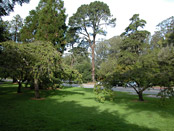
Trees at the edge of MLK Drive near the Botanical Garden's Friend Gate
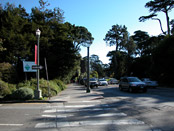
MLK Drive at Tea Garden Drive, facing east
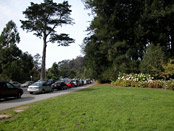
Lawn adjacent to MLK Drive, near the Japanese Tea Garden
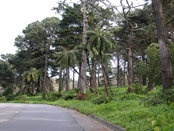
Tree Ferns on MLK Drive, near the 25th Avenue entrance
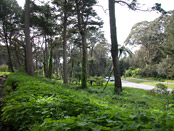
MLK Drive from the path above near Mallard Lake
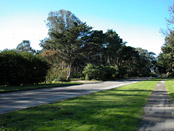
MLK Drive at 41st Avenue, near Chain of Lakes Drive
Arizona Garden
- Back to Top
This garden begins on the rise just east of the Conservatory of Flowers building, and continues up to Conservatory Drive West. It features cactus and desert plants, and frames views of the Conservatory Valley below.
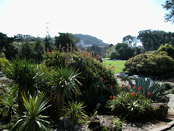
Arizona Garden, at the walkway just east of the Conservatory of Flowers
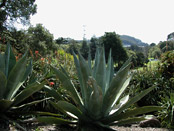
Plants in the Arizona Garden northeast of the Conservatory of Flowers
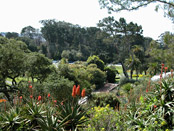
View north toward JFK Drive from the Arizona Garden
Dahlia Garden
- Back to Top
Dahlias (the official flower of San Francisco) are planted in diverse colors in a thick, fenced-in patch on the east side of the Conservatory of Flowers. These are at full bloom in late August and September.
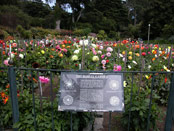
The Dahlia Garden, on the east side of the Conservatory of Flowers
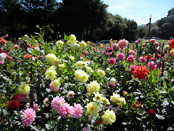
Flowers in the Dahlia Garden
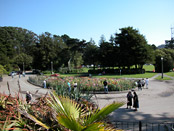
The Dahlia Garden, from the walkway above
Conservatory of Flowers
- Back to Top
Originally assembled from crated pieces between 1877 and 1878 (at a cost of $2,050), this glass and wood greenhouse has weathered storm damage, fire, and the 1906 earthquake. The entire structure was virtually taken apart and put back together in a four-year, $25 million dollar restoration which was completed in 2003. Exotic plants and themed exhibitions are on display in the steamy chambers of its interior. Open Tuesday through Sunday, 9am to 5pm. $7 regular adult admission. 415-831-2090. Website.
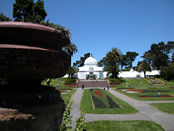
Conservatory of Flowers from the front
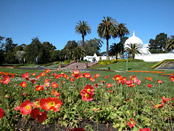
Flower beds in the Conservatory Valley, in front of the Conservatory of Flowers building
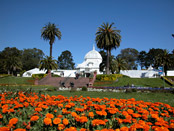
Orange flowers in the beds at the Conservatory of Flowers
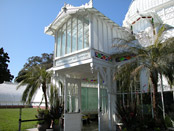
Entrance to the Conservatory of Flowers building
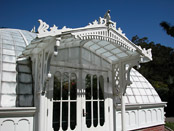
East wing of the Conservatory of Flowers building
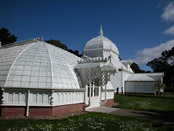
West wing of the Conservatory of Flowers building
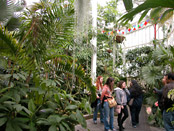
Inside the Conservatory of Flowers greenhouse near the front entrance
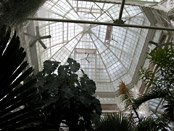
The ceiling of the center of the Conservatory of Flowers greenhouse
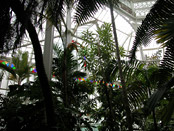
Palms inside the middle section of the Conservatory of Flowers greenhouse
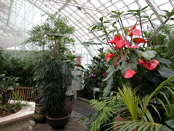
Potted plants inside the Conservatory of Flowers greenhouse
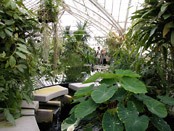
Aquatic plants in the Conservatory of Flowers greenhouse
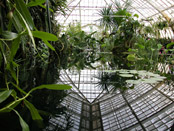
Reflection of the ceiling in the pool in the aquatic room inside the Conservatory of Flowers greenhouse
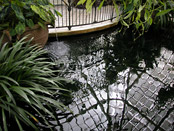
Ripples in the water reflecting the ceiling in the Conservatory of Flowers greenhouse
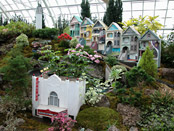
Part of the special exhibit in the Conservatory of Flowers greenhouse
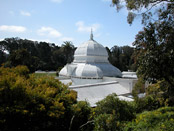
Back of the Conservatory of Flowers, from Conservatory Drive West
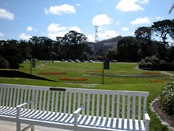
Bench in front of the Conservatory of Flowers, overlooking the Conservatory Valley
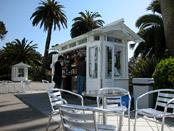
Tiny gift shop at the Conservatory of Flowers
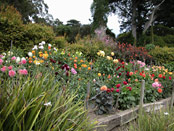
Flower beds east of the Conservatory
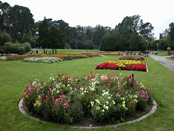
Flower beds in front of the Conservatory
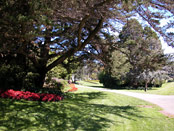
Path connecting JFK Drive and the west side of the Conservatory of Flowers
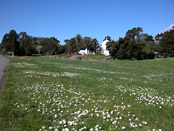
Meadow at JFK Drive just east of Conservatory Valley
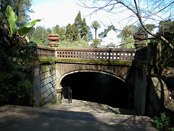
The Pedestrian Tunnel under JFK Drive at the Conservatory of Flowers
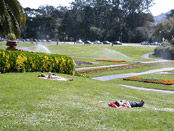
Sunbathing on the lawn at the Conservatory of Flowers in March - it rained later that day
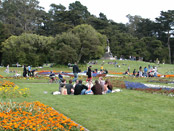
Picnics on the lawn in the Conservatory Valley
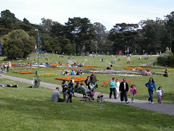
The Conservatory Valley on a Sunday afternoon
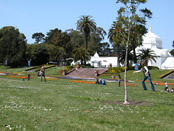
Frisbee players on the meadow in front of the Conservatory of Flowers
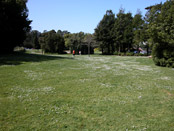
Picnic area east of the Conservatory of Flowers
Clarke Gate
- Back to Top
These sandstone pillars were installed in 1915 at the Arguello Boulevard entrance to the park from Fulton Street. The gate is named in memory of an early Presidio area settler named Crawford Clarke, and is a gift from his wife. Decorative urns are situated on the side of each pillar.
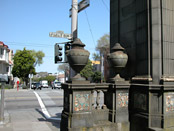
Clarke Gate, at the entrance to the park at Arguello Boulevard and Fulton Street
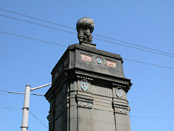
Top of the column at Clarke Gate
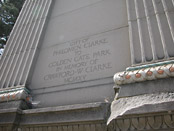
Inscription on the column of Clarke Gate
Raccoon Hollow/Live Oak
- Back to Top
A valley of live oak, bushes, and wild grasses behind the Conservatory of Flowers, between Fulton Street and Conservatory Drive West. Winding paths lead through the area, which is green in the spring and dry and brushy later in the year.
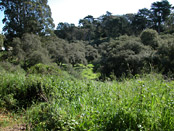
Raccoon Hollow and Native Live Oak, thick brushy area behind the Conservatory of Flowers, at Fulton Street
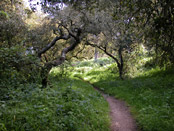
Path inside the Native Live Oak area behind the Conservatory of Flowers
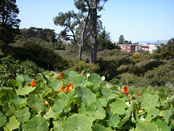
Flowers on the east edge of the Native Live Oak area, at Arguello Boulevard
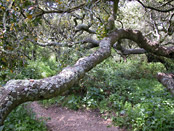
Trunks and branches of the Native Live Oak
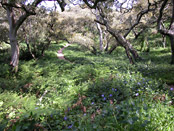
Ferns along the paths inside the Native Live Oak area
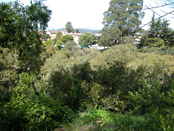
View to the north over the Native Live Oak, from Conservatory Drive West
Ghiradelli Rustic Shelter
- Back to Top
The current structure is one of a line of several which have stood on this site and have been associated with monetary gifts from the Ghiradelli family. This one was built in 1988 from parts of a previous structure.
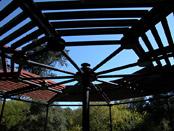
Ceiling of the Ghiradelli Rustic Shelter
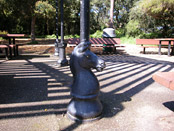
Chess horse in the Ghiradelli Rustic Shelter
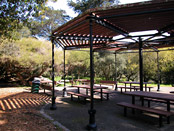
Tables for picnic or games at the Ghiradelli Rustic Shelter
George Washington Elm
- Back to Top
According to the plaque beneath this tree, its parent tree was the one under which George Washington began his military command. This tree was planted in 1932 and can live up to 200 years.
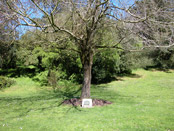
George Washington Elm, at JFK Drive across from the Tree Fern Dell
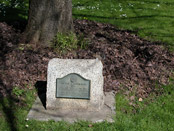
Plaque beneath the George Washington Elm, explaining that it is the descendent of a tree associated with Washington
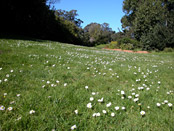
Meadow behind the George Washington Elm, near the Ghiradelli Rustic Shelter
Tree Fern Dell
- Back to Top
Impressively primordial in appearance, these groups of New Zealand ferns tower over other flora and lean out over the paths just south of the Conservatory of Flowers and toward the Lily Pond. This area was referred to during the 1960s as Mescaline Grove.
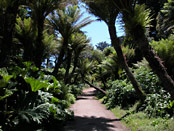
Tree Fern Dell, south of the Conservatory of Flowers
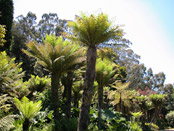
Trees in the Fern Dell
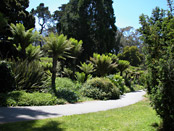
Walking path in the Tree Fern Dell
Lily Pond
- Back to Top
Not many years ago, this was one of the most idyllic spots in the park. The beautifully landscaped pond featured floating waterlilies and families of ducks.
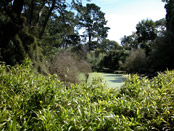
Lily Pond, south of the Fern Tree Dell, not looking very good
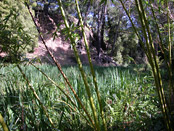
Thick reeds in the east section of the Lily Pond
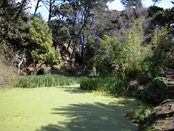
Shadows falling over the Lily Pond
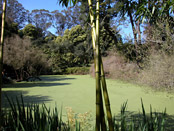
Babmoo stalks at the east edge of the Lily Pond
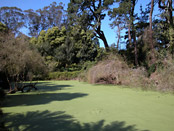
The Lily Pond, facing east
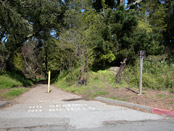
Path leading to the Lily Pond from Middle Drive East
DeLaveaga Dell/AIDS Memorial Grove
- Back to Top
This area of the park was opened in 1925 as DeLaveaga Dell, after the donor who financed the landscaping and planting of the grove, and creation of the adjacent dry creek bed. In the 1990s it was restored and cleaned up by volunteer groups, and the limestone memorial circle was installed. The official AIDS Memorial Grove designation was made in 1996. Website.
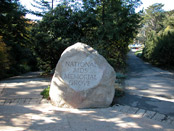
Stone marker at the entrance to the National AIDS Memorial Grove, near Bowling Green Drive
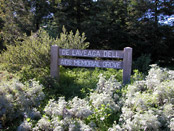
Sign at the entrance to the Delaveaga Dell and AIDS Memorial Grove
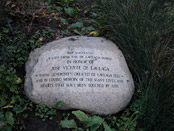
Stone marker at the beginning of the south path to the AIDS Memorial Grove, from Bowling Green Drive
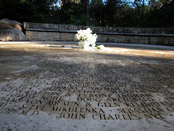
Center of the AIDS Memorial Grove
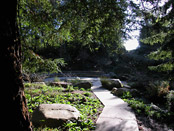
Path leading to the center of the AIDS Memorial Grove
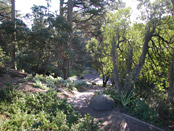
Steps leading down to the AIDS Memorial Grove near Bowling Green Drive and Middle Drive East
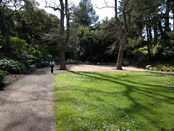
Meadow in the center of the DeLaveaga Dell and AIDS Memorial Grove
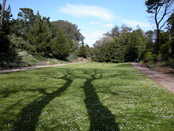
Facing east at the meadow inside the AIDS Memorial Grove
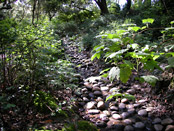
Stream inside the AIDS Memorial Grove area, after the rainy season
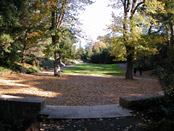
Exiting the Dry Creek Path to the lawn in the AIDS Memorial Grove
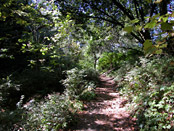
Path in the dry creek section of the AIDS Memorial Grove
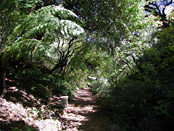
Bench in the dry creek trail
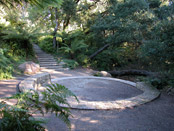
Circle at the beginning of the Dry Creek Trail in the AIDS Memorial Grove
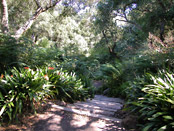
Steps leading from the dry creek section of the AIDS Memorial Grove
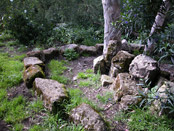
Stones in a ring around a tree on a path west of the AIDS Memorial Grove
Tennis Courts
- Back to Top
Home to the Tennis Club established in 1901, there are 21 public courts available with reservation. The bowl-shaped area originally featured a music stage, or band shell (dedicated in 1888), and subsequently a croquet court. 415-831-6302.
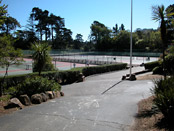
Tennis Courts, just south of JFK Drive
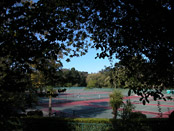
Tennis Courts, from the walking path on the southwest side
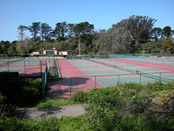
Tennis Courts, from the east side
Lawn Bowling Courts
- Back to Top
Two enclosed courts of very flat grass are situated across from each other on Bowling Green Drive, just west of Sharon Meadow. Lessons are available if you're not sure how to lawn bowl. 415-753-9298.
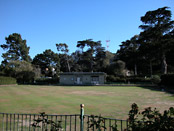
Lawn Bowling Court east of Bowling Green Drive
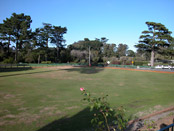
Lawn Bowling Court on the west side of Bowling Green Drive
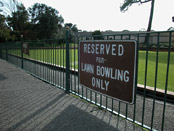
Sign on the Lawn Bowling Court on the west side of Bowling Green Drive
Brayton Gate
- Back to Top
The curved benches framing the entrance to the park at 6th Avenue were installed in 1952. Vehicles cannot enter at this point, and it marks the entrance associated with the designated Skate Area.
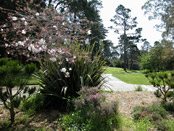
Entry way to the park at the Brayton Gate at 6th Avenue and Fulton Street
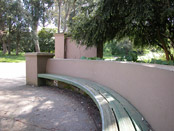
One of two curved benches facing Fulton Street at the Brayton Gate
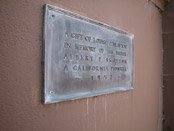
Inscription at the Brayton Gate
Skate Area
- Back to Top
The 6th Avenue skating area is just inside the park between Fulton Street and JFK Drive. Skaters are most active on Sundays, when JFK Drive is closed to vehicular traffic.
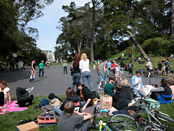
The Skate Area at 6th Avenue between Fulton Street and JFK Drive on a Sunday
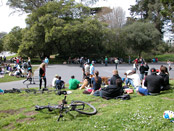
Looking down on the 6th Avenue Skate Area from the rise on the east side
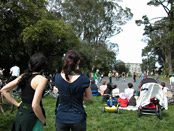
Spectators watching the skaters on 6th Avenue near Fulton Street
Garden of Humanitarians
- Back to Top
This area was renovated with a 2004 grant from the San Francisco Beautiful Foundation and its program in honor of Friedel Klussmann, rescuer of the city's cable cars. The intent was to provide a designated spot for school children to learn about humanitarians around the world.
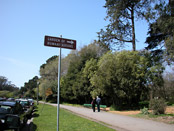
Sign pointing to the Garden of Humanitarians and picnic area from JFK Drive at 7th Avenue
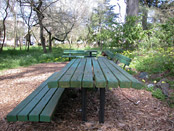
Picnic table at the Garden of Humanitarians
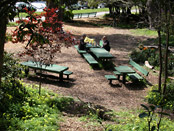
Picnic area in the Garden of Humanitarians
Powell Railroad Entrance
- Back to Top
The Powell Street Railroad Station structure at 7th Avenue was actually used as a terminal point for steam trains, and later cable cars, bringing visitors to the park.
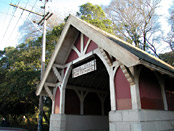
Powell Street Railroad Station at Fulton and 7th Avenue park entrance
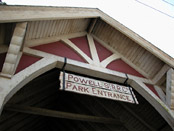
Sign on the Powell Street Railroad Park Entrance structure
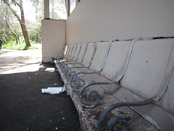
Seats inside the Powell Street Railroad Entrance
Brown Gate
- Back to Top
Bronze sculptures of a bear and cougar, installed in 1908, adorn either side of the Brown Gate entrance at Eighth Avenue.
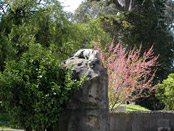
The Brown Gate, with bronze sculpted animals installed in 1908
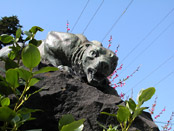
Bronze cougar on the west granite pillar of the Brown Gate at 8th Avenue and Fulton Street
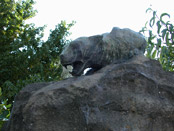
Cougar at the Brown Gate entrance
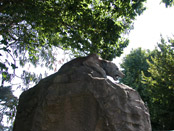
Bear at the Brown Gate entrance, at 8th Avenue
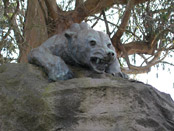
Bonze bear on the east pillar of the Brown Gate
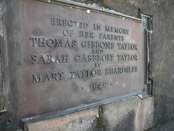
Inscription on the Brown Gate, indicating the source of funds for a 1948 renovation
McLaren Rhododendron Dell
- Back to Top
As of spring 2010, this area is still undergoing renovation. New paved paths and drainage gutters have been added throughout the dell, with disabled access. The statue at the dell entrance of Park Superintendent John McLaren was sculpted around 1911 and installed in 1945, two years after McLaren's death.
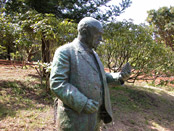
Statue of Park Superintendent John McLaren, at the entrance to the Rhododendron Dell at JFK Drive
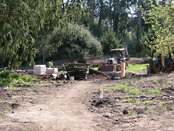
Renovation continues at the entrance to the McLaren Rhododendron Dell, at JFK Drive near 6th Avenue
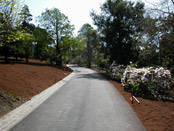
Newly laid paths inside the McLaren Rhododendron Dell
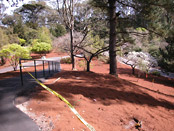
Hill inside the newly redeveloped McLaren Rhododendron Dell
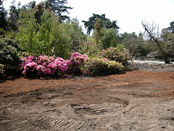
Landscaping in the McLaren Rhododendron Dell is incomplete
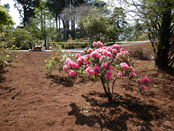
Rhododendrons in the dell, still undergoing redevelopment
Maintenance Yard/Nursery
- Back to Top
This is one of a few areas in the park off limits to visitors. The Nursery area contains plant specimens to be planted in the park. Maintenance vehicles are often parked here.
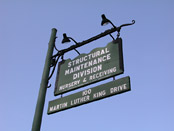
Sign at the entrance of the Maintenance Yard and Nursery, where MLK Drive meets Bowling Green Drive
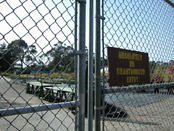
The Maintenance Yard and Nursery is surrounded by a fence and off limits to visitors
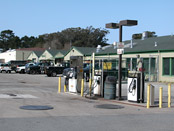
Gas pumps inside the Maintenance Yard facility
Whiskey Hill
- Back to Top
A shady wooded hill with an appropriate name and secluded paths bordering Lincoln Way. A trail begins just south of the Big Rec Ball Field at 7th Avenue and continues through a dog run area, up the hill, and down toward the Children's Playground.
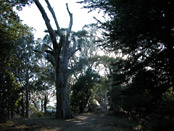
Whiskey Hill, wooded area near 3rd Avenue and Lincoln Way
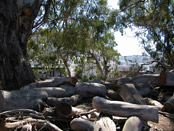
View of Lincoln Way from Whiskey Hill
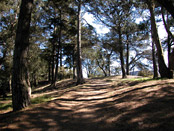
Path leading up to Whiskey Hill from the west side
Comments
Comment about the East section of Golden Gate Park here:
